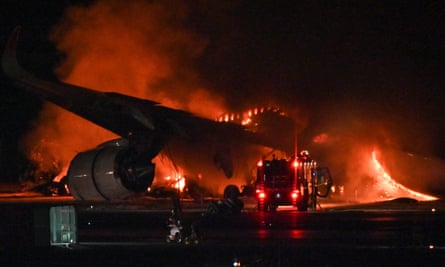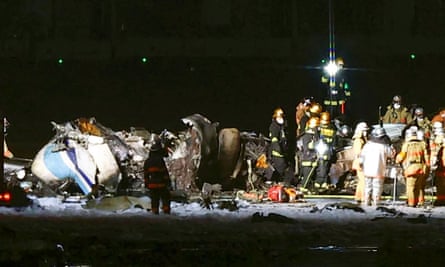All crew and passengers onboard a Japan Airlines jet managed to make what has been described as a “miracle” escape after a horrific collision on a runway at Haneda airport in Tokyo that killed five crew members of a coastguard plane.
JAL flight 516, an Airbus A350-900, was engulfed in flames soon after landing as it struck the smaller coastguard aircraft, which was waiting to deliver aid to the earthquake-hit Noto peninsula.
Once the captain of the commercial jet managed to bring the burning aircraft to a stop, its 379 passengers, including eight children, plus 12 crew fled the plane’s smoke-filled cabin by sliding down inflatable slides at its front.
The jet was soon entirely overcome by fire, with flames seen licking out of the cabin’s windows. The Tokyo fire department said 14 of those evacuated from the passenger plane suffered minor injuries including burns to the throat. Four were taken to hospital.
Five of the six people onboard the coastguard plane, a De Havilland Canada DHC-8, commonly known as the Dash 8, were killed in the collision but its captain managed to escape the inferno with injuries.
Shigenori Hiraoka, head of the transport ministry’s civil aviation bureau, said the collision had occurred when the passenger plane landed on runway C – one of the airport’s four runways – from where the coastguard aircraft had also been preparing to take off.
Rodger Whitfield, a former commercial pilot, said: “I think first of all, you’ve got to say that we just witnessed a miracle. The way they got all those passengers off that aeroplane is almost beyond belief.”
Passengers on the Japan Airlines jet, which had arrived at about 5.47pm local time from New Chitose airport on the northern island of Hokkaido, spoke of their terror after hearing the thud of the initial impact.
Social media footage from within the cabin showed how passengers could see the flames at the back exterior of the plane through the cabin windows as it continued down the runway immediately after the collision.

The cabin crew organising the evacuation had sought to keep the passengers calm but asked those who reached for their baggage to leave their belongings behind. The lights then went off and the temperature inside the cabin started rising, survivors said. The passengers were guided through the dark and the thick smoke by cabin crew holding torches.
“Smoke began to fill the plane, and I thought: ‘This could be really bad,’” said one male passenger. “An announcement said doors in the back and middle could not be opened. So everyone disembarked from the front.”
Live television footage of the initial collision showed a landing jet about to touch down at night before a bright orange flash, with the plane rolling down the runway with flames and smoke trailing behind it.
“I felt a boom like we had hit something and jerked upward the moment we landed,” a passenger on the Japan Airlines flight told Kyodo news agency. “I saw sparks outside the window and the cabin filled with gas and smoke.”
Another posted on social media: “For the first time in my life, I felt that my life was in danger. I was sitting in seat 45H of the [Airbus] A350 and immediately after the huge impact, flames erupted from both wings. Only the front hatch could be opened and while the cabin was filled with smoke I escaped with only my cell phone in my hand.”
A 47-year-old office worker from Ota ward, Tokyo, told the Yomiuri Shimbun newspaper that she had been sitting in the centre of the plane when she heard a huge thud. She looked out of the window to see smoke billowing from the wings, at which point she felt hot air around her face.
She said: “Smoke filled the cabin, and passengers shouted: ‘It’s on fire! It’s on fire!’”
Anton Deibe, 17, a Swedish passenger told the newspaper Aftonbladet that “the entire cabin was filled with smoke within a few minutes. We threw ourselves down on the floor. Then the emergency doors were opened and we threw ourselves at them”.
He added: “The smoke in the cabin stung like hell. It was a hell. We have no idea where we are going so we just run out into the field. It was chaos.”

Once the jet had been emptied of passengers firefighters from 110 fire engines tackled the blaze on the plane, which had become bent over on its nose after the collapse of its landing gear. The plane was also broken in two, with the tail of the aircraft detached from the main fuselage. The fire was extinguished by 8.30pm, nearly three hours after the initial impact.
The ministry of land, infrastructure, transport and tourism and the national transportation safety board was investigating why both planes were on the same runway.
Noriyuki Aoki, general manager of Japan Airlines, said the passenger jet was “understood to have been cleared to land”.
Hiroyuki Kobayashi, an aviation expert and former Japan Airlines pilot, told the local broadcaster NHK that the communications between air traffic control and the planes would be at the centre of the investigation.
He said: “It’s possible that one of the planes misheard the instructions about which runway they were supposed to land on.”
The coastguard plane had been preparing to fly to Niigata airport on Japan’s west coast to deliver supplies after the New Year’s Day earthquake that killed at least 48 people.

Japan’s prime minister, Fumio Kishida, praised the crew members, who were on their way to help the victims of the quake. He said: “These were employees who had a high sense of mission and responsibility for the affected areas. It’s very regrettable. I express my respect and gratitude to their sense of mission.”
The airport suspended domestic flights for the day, according to its website, but most international takeoffs and landings were still operating. Airbus in a statement said it was sending specialists to help.
The Australian prime minister, Anthony Albanese, said 12 Australians were on board the plane at the time of the crash and all escaped uninjured.